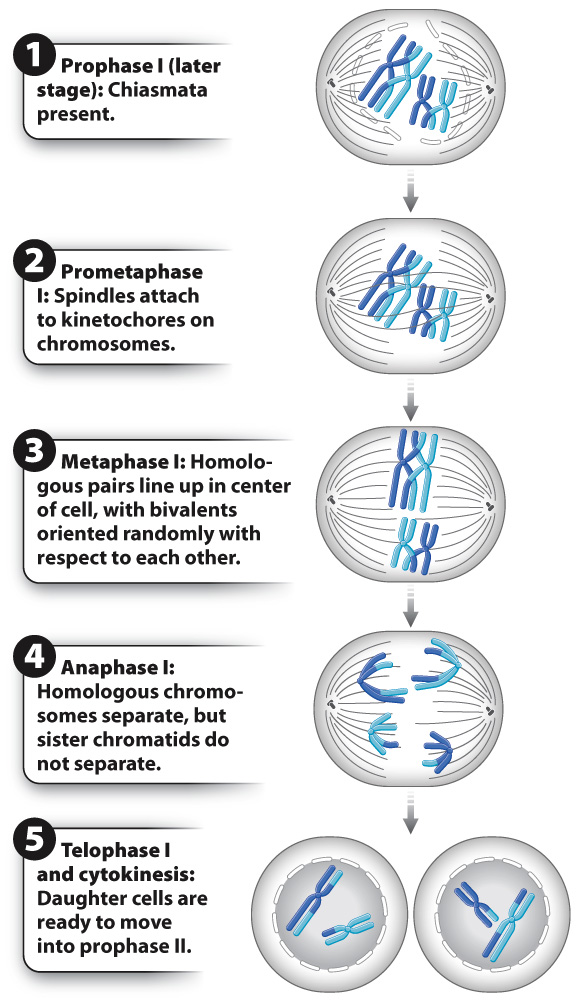The first meiotic division brings about the reduction in chromosome number.

At the end of prophase I, the chromosomes are fully condensed and have formed chiasmata, the nuclear envelope has begun to disappear, and the meiotic spindle is forming. We are now ready to move through the remaining stages of meiosis I, which are illustrated in Fig. 11.10.
In prometaphase I, the nuclear envelope breaks down and the meiotic spindles attach to kinetochores on chromosomes. In metaphase I, the bivalents move so that they come to lie on an imaginary plane cutting transversely across the spindle. Each bivalent lines up so that its two centromeres lie on opposite sides of this plane, pointing toward opposite poles of the cell. Importantly, the orientation of these bivalents is random with respect to each other. For some, the maternal homolog is attached to the spindle radiating from one pole and the paternal homolog is attached to the spindle originating from the other pole. For others, the orientation is reversed. As a result, when the homologous chromosomes separate from each other in the next step, a complete set of chromosomes moves toward each pole, and that chromosome set is a random mix of maternal and paternal homologs. The random alignment of chromosomes on the spindle in metaphase I further increases genetic diversity in the products of meiosis.
At the beginning of anaphase I, the two homologous chromosomes of each bivalent separate as they are pulled in opposite directions. The key feature of anaphase I is that the centromeres do not split and the two chromatids that make up each chromosome remain together. This occurs because spindle microtubules from one pole of the cell attach to both kinetochores of a given chromosome during prometaphase I. Anaphase I is thus very different from anaphase of mitosis, in which the centromeres split and each pair of chromatids separates.
The end of anaphase I coincides with the arrival of the chromosomes at the poles of the cell. Only one of the two homologous chromosomes goes to each pole, so in human cells there are 23 chromosomes at each pole at the end of meiosis I, which is the haploid number of chromosomes. Each of these chromosomes consists of two chromatids attached to a single centromere. Meiosis I is sometimes called the reductional division since it reduces the number of chromosomes in daughter cells by half.
In telophase I, the chromosomes may uncoil slightly and a nuclear envelope briefly reappears. In many species (including humans), the cytoplasm divides, producing two separate cells. The chromosomes do not completely decondense, however, and so telophase I blends into the first step of the second meiotic division. Importantly, there is no DNA synthesis between the two meiotic divisions.
Quick Check 5 List three ways in which meiosis I differs from mitosis.
Quick Check 5 Answer
In meiosis I, homologous chromosomes pair, undergo crossing over, and segregate from each other. These events do not occur in mitosis. In mitosis, centromeres divide and sister chromatids separate, events that do not take place in meiosis I.